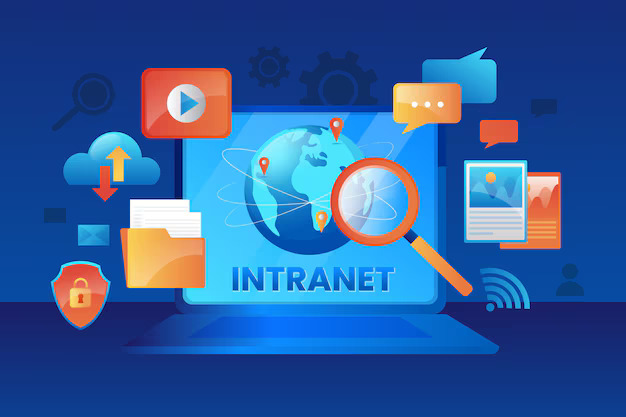Many organizations now have offices and workers globally, making seamless communication a major challenge. Intranets provide a secure, centralized platform that allows teams to share information and collaborate efficiently, no matter where they are located. This technology streamlines workflows, minimizes miscommunication, and significantly boosts productivity across the board.
Understanding Intranet Communications
An intranet, such as SharePoint, is a private network accessible exclusively to an organization’s employees. It serves as a central hub where team members can access company information, collaborate on projects, share resources, and communicate effectively across departments. Unlike the public internet, intranets are secure platforms tailored to meet the specific needs of an organization, ensuring that sensitive information remains protected.
Why Intranet Communications Matter
Intranet communications offer several benefits that are critical for organizational success:
- Centralized Information Repository Intranets function as centralized repositories for critical company information such as policies, procedures, HR updates, and departmental announcements. This ensures employees have access to accurate and up-to-date information, promoting consistency and reducing confusion across the organization.
- Enhanced Collaboration Effective collaboration is essential for driving innovation and achieving business objectives. Intranet platforms provide tools such as project management software, document sharing, and real-time messaging that facilitate seamless collaboration among team members. Whether employees are working in the same office or remotely, they can easily share ideas, contribute to projects, and coordinate efforts effectively.
- Clear Communication Clear and transparent communication is vital for preventing misunderstandings and aligning everyone toward common goals. Intranet communications offer various channels such as instant messaging, discussion forums, and company-wide announcements, enabling efficient communication regardless of location or time zone. This fosters a more connected and engaged workforce.
- Streamlined Processes By integrating workflows and automating routine tasks, intranets help streamline internal processes. For instance, employees can submit leave requests, expense reports, or IT support tickets through the intranet, reducing administrative overhead and ensuring faster response times. This efficiency not only saves time but also enhances overall productivity.
- Support for Remote Teams With the rise of remote work, intranet communications play a crucial role in supporting dispersed teams. They provide virtual meeting spaces, collaborative tools, and access to essential resources, allowing employees to stay connected and productive irrespective of their physical location.

The Power of SharePoint for Effective Intranet Communications
SharePoint provides a robust set of out-of-the-box solutions that help businesses create their own intranet easily and efficiently. Boasting a rich set of tools, SharePoint addresses the downsides of managing intranet communications and networks. Utilizing SharePoint, users can manage files and documents more proficiently, collaborate with other users conveniently, and customize their workstations to optimize workflow.
Aside from the quality of life improvements for users, SharePoint features a robust security platform, allowing administrators to precisely control user authorization. These tools provide a powerful solution that enhances the advantages while mitigating the disadvantages of using an intranet network.
Benefits of Intranet Communications
- Increased Productivity By providing easy access to information and tools, intranets remove barriers to productivity and allow employees to focus on their core responsibilities.
- Cost Savings Streamlined processes and reduced reliance on paper-based communication can lead to significant cost savings over time.
- Employee Engagement A well-implemented intranet fosters a sense of belonging and keeps employees informed and engaged with company news and updates.
- Data Security Intranets provide secure environments that safeguard sensitive company information from unauthorized access, ensuring compliance with data protection regulations.
How Intranet Communications Transform the Workspace
The ability to create an internal and secure platform has enabled businesses to collect, organize, and manage information relating to the company and its procedures. By centralizing communication channels, intranets allow users to quickly access, share, and contact other members, ensuring nothing is lost in the clutter. This capability enhances productivity and efficiency within the organization.
However, it is important to acknowledge some limitations of intranets:
- Security Risks Due to the centralized nature of intranets and the vast amounts of sensitive data they hold, they become lucrative targets for hackers. A single breach can potentially expose the entire network.
- Data Overload Without proper organization and management, the sheer volume of data stored can overwhelm users, for example, they can struggle to find what they are looking for or the internet can not work efficiently because it might become too slow.
- Maintenance Requirements Keeping an intranet relevant and effective requires continuous management and updates. Over time, content can become outdated, and software may require patches or upgrades.
- Implementation Challenges Implementing an intranet can be resource-intensive, requiring careful planning and significant investment in technology infrastructure.
Intranet communications are not merely a technological convenience but a strategic asset that drives organizational success. By facilitating seamless communication, enhancing collaboration, and optimizing workflows, intranets empower teams to work more efficiently and achieve better outcomes. As businesses continue to evolve due to everything becoming more digital, investing in robust intranet solutions like SharePoint is essential to staying competitive and fostering a dynamic and engaged workforce.
Despite some limitations, the benefits of using intranets, particularly those powered by platforms like SharePoint, are significant. Businesses looking to boost productivity and engagement should consider investing in a well-implemented intranet system to transform how their teams collaborate, communicate, and innovate.














 Follow @cardiolog
Follow @cardiolog